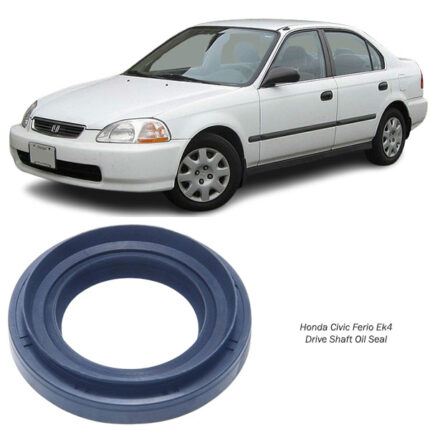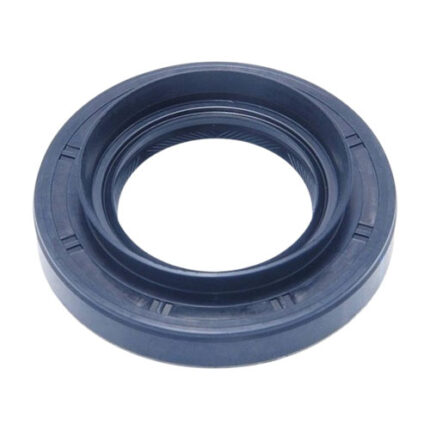-20%
Get Toyota Hilux Drive Shaft Oil Seal 38X58X11
A drive shaft oil seal, also known as an axle seal, is a component used in automotive drivetrains to prevent transmission fluid or differential oil from leaking out of the transmission or differential housing where the drive shaft enters. It’s typically located at the point where the drive shaft connects to the transmission or differential, sealing the gap between the stationary housing and the rotating drive shaft.
Components and Design:
Drive shaft oil seals are typically made of rubber or synthetic rubber-like materials, with a metal casing or reinforcement to provide structural support. They feature a sealing lip or edge that makes contact with the surface of the rotating drive shaft, creating a barrier to prevent fluid leakage.
Benefits;
- Fluid Containment:
- The primary function of the drive shaft oil seal is to contain transmission fluid or differential oil within the transmission or differential housing. This prevents leakage, ensures proper lubrication of internal components, and maintains the integrity of the drivetrain system.
- Prevention of Contamination:
- By sealing the interface between the drive shaft and the transmission or differential housing, the oil seal prevents contaminants such as dirt, water, and debris from entering the drivetrain system. This helps maintain the cleanliness and efficiency of the transmission or differential components.
- Reduced Wear and Tear:
- A properly functioning drive shaft oil seal helps minimize wear and tear on internal drivetrain components by ensuring they are adequately lubricated with transmission fluid or differential oil. This extends the lifespan of critical components such as bearings, gears, and shafts.
- Protection Against Corrosion:
- By preventing moisture and contaminants from entering the transmission or differential housing, the oil seal helps protect internal components from corrosion and rust. This is particularly important for maintaining the longevity and reliability of the drivetrain system, especially in harsh environmental conditions.
- Optimized Performance:
- Maintaining proper fluid levels and preventing leaks ensures optimal performance of the transmission or differential. Proper lubrication helps reduce friction, heat buildup, and component wear, resulting in smoother operation, improved fuel efficiency, and enhanced overall performance of the vehicle.
- Enhanced Safety:
- A well-maintained drive shaft oil seal contributes to the safety of the vehicle by ensuring the drivetrain operates smoothly and efficiently. Preventing fluid leaks and maintaining proper lubrication helps reduce the risk of drivetrain malfunctions or failures, which could lead to loss of control or accidents on the road.
- Cost Savings:
- Regular inspection and replacement of worn or damaged drive shaft oil seals can help prevent costly repairs or component replacements associated with drivetrain damage caused by fluid leaks or contamination. Investing in proper maintenance and timely replacement of oil seals can lead to long-term cost savings and increased vehicle reliability.
Signs of a worn out Drive Shaft Oil Seal ;
- Transmission or Differential Fluid Leak:
- One of the most common signs of a worn drive shaft oil seal is a fluid leak around the area where the drive shaft enters the transmission or differential housing. You may notice fluid dripping from the rear of the transmission or differential, or it may accumulate on the ground under the vehicle.
- Low Fluid Levels:
- If you consistently notice a decrease in transmission or differential fluid levels without any apparent leaks elsewhere, it could indicate that the oil seal is allowing fluid to escape.
- Visible Damage or Wear:
- During a visual inspection, you may notice signs of wear or damage on the oil seal itself. This can include cracks, tears, or deterioration of the rubber sealing lip. Any visible damage to the seal indicates that it needs to be replaced.
- Contaminated Brake Components:
- A leaking drive shaft oil seal can cause transmission or differential fluid to be flung onto nearby brake components, such as the brake calipers, rotors, or pads. Contaminated brake components can lead to reduced braking performance or brake failure.
- Vibrations or Noise:
- In some cases, a worn drive shaft oil seal can allow excessive movement or play in the drive shaft, leading to vibrations or noise while driving. This can occur due to a lack of proper lubrication or support caused by fluid leakage.
- Burning Smell:
- If transmission or differential fluid leaks onto hot engine components, it can produce a burning smell inside the cabin. This odor is often noticeable when the vehicle is stationary or shortly after driving.
- Reduced Drivetrain Performance:
- A worn drive shaft oil seal can lead to a loss of transmission or differential fluid, which can affect the performance and operation of the drivetrain. You may experience hesitation, slipping, or rough shifting when accelerating or changing gears.
- Visible Oil Residue:
- Upon inspecting the area around the drive shaft where it enters the transmission or differential housing, you may notice oil residue or buildup. This residue can accumulate over time as fluid leaks past the worn oil seal.
Follow us on Facebook for more parts.





